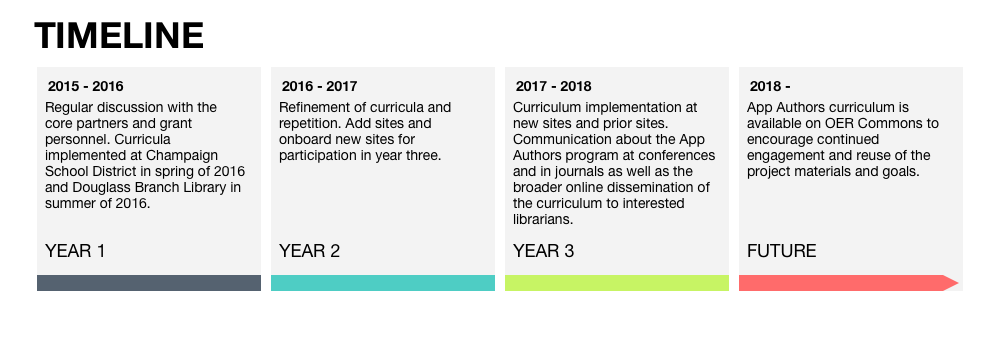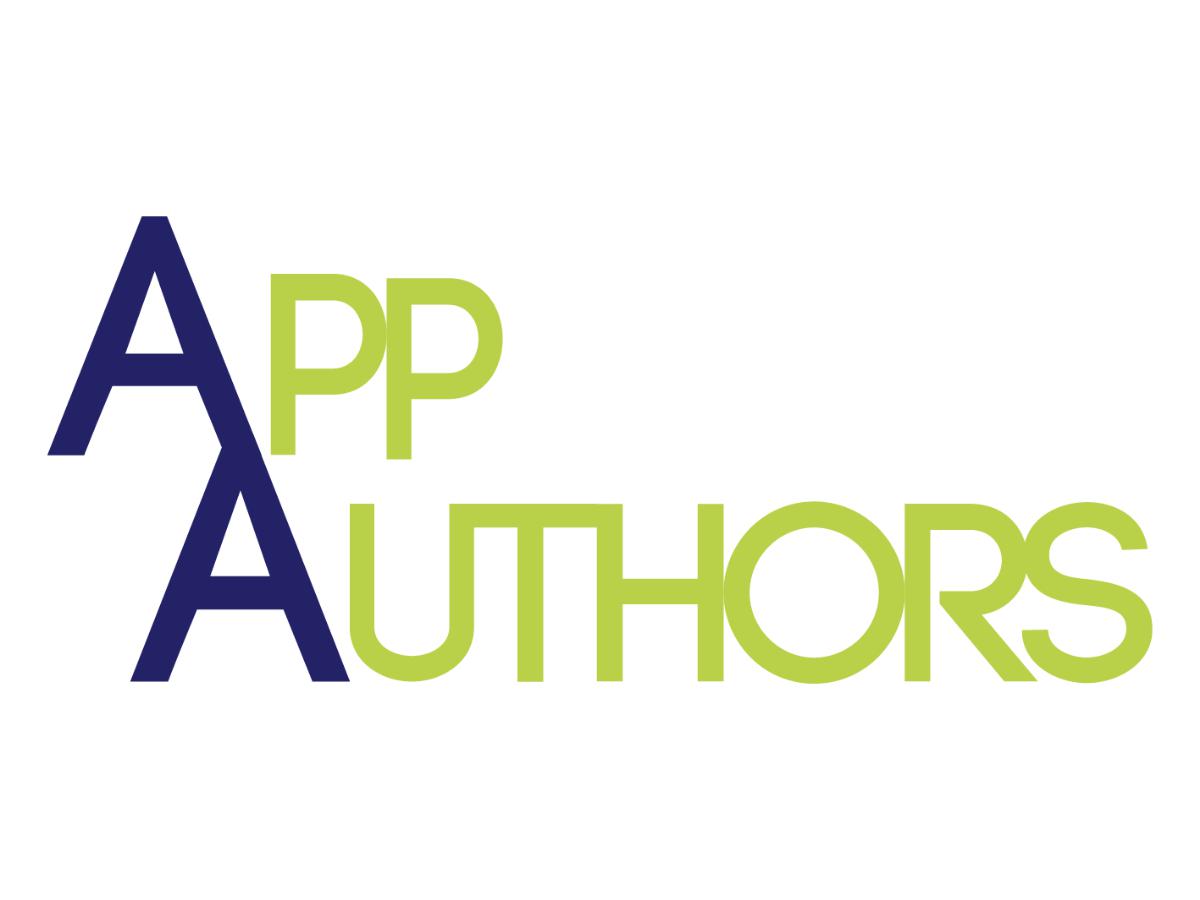App Authors
What is App Authors?
App Authors is a curriculum designed for librarians and K-12 educators to use in school and public libraries for teaching coding to children eight to twelve through the use of app design on the Code.org Play Lab and App Lab platforms. The App Authors curriculum provides lesson plans and app development activities that can be used in a seven-week sequential course, semi-sequential course, or non-sequential course, so that it can be used with participants who attend every session or with participants who drop in for a session or two. It's an accessible curriculum that allows professionals with no more than average technical expertise to come up to speed quickly.
The curriculum focuses not just on learning to code but also developing twenty-first century skills such as critical thinking, problem solving, collaboration, and failing forward (understanding the importance of making mistakes in creating). The sessions involve multiple modalities—"unplugged" work, worksheets, games, YouTube and Vimeo channels, and design on paper as well as direct coding experience—and each curriculum outlines learning objectives and lists recommended supplies (in addition to hardware, craft-type supplies such as notecards, glue, and drawing materials).
The curriculum comes out of our project App Authors: Closing the App Gap II,
which is run by Dr. Deborah Stevenson, Director of the Center for
Children’s Books, with co-PI's Dr. Kate McDowell, Associate Professor,
and Dr. Rachel Magee, Assistant Professor at the School of Information
Sciences at the University of Illinois at Urbana-Champaign. It is funded
by the Institute of Museum and Library Services, and we were greatly assisted by our tech consultants at Pixo in Urbana, IL. Our goal in the project, which involved testing the curriculum in libraries locally and across the country, was to expand the role of libraries in creating STEM learning spaces for young
people, especially those young people who have limited access to
technology at home. Extracurricular programming allows young people the chance to explore
and play, make mistakes and learn, outside of the confines of the
classroom. Apps provide an excellent entry point for coding and
STEM explorations, since even young people without their own tablets or
smartphones are likely to possess basic competency with their
interfaces and find them appealing. We find that even children who've struggled with computer science in the classroom find the App Authors curriculum understandable and readily achieve success with it. We hope you will find that too.
App Authors Pioneer Partners
- Kenwood Elementary School, Champaign, IL; Miriam Larson, Library Media Specialist
- Douglass Branch Library of Champaign Public Libraries, Champaign, IL; Amanda Raklovits, Children’s Librarian
- Frederick County (MD) Public Libraries, Janet Vogel, Youth Services Coordinator
- Springfield (OR) Public Library, Emily David, Associate Manager of Youth and Adult Services
Project Timeline

Timeline image

App Authors
Literature Review
The following list of sources about libraries and coding programs were used in the research phase of developing the App Authors curriculum.
Alexander, K. (2016). IL Teen Creates Library App. School Library Journal, 62(7), 12.
“The article features LibraryXs, a library software that will be used by students at John Jersey High School in Chicago, Illinois in the school year 2016-2017.”
Barack, L. (2013). Kids Game Class, Teacher Approves. School Library Journal, 59(4), 10.
“The article discusses interactive fiction as a tool to improve students' writing skills, and offers information on a project in which the teacher Jason Sellers taught his students computer code in order to allow them to create interactive stories. The article also describes the creativity needed for coding.”
Barack, L. (2014). Not Your Mama's Library Program. School Library Journal, 60(3), 14.
“The article discusses 2014 summer technology camps for young people held by U.S. school and public libraries. Topics discussed include computer coding that students will learn at camp, camps geared specifically for girls, and the work of school librarian Melissa Techman from Broadus Wood Elementary School in Earlysville, VA and teen librarian Justin Hoenke from the Chattanooga Public Library in Chattanooga, Tennessee.”
Barack, L., & Enis, M. (2016). Where Teens Teach. School Library Journal, 62(4), 30.
“The article focuses on the formation of the peer-to-peer programming at the Santa Clara County Library District in California. The history of how the program started, which has attracted hundreds of students who wanted to engage in coding classes on Java and Python, learn from technology and learn from science experts to develop apps is provided. The advantage of the program which resulted to the branch's first hackathon in which 143 teens have competed to build apps is mentioned.”
Bell, M. l. (2014). What About the Kids?. Internet@Schools, 21(3), 12-13.
“The article presents ideas that capitalize on technology and are used to enhance learning and also engender positive feelings with students. It suggests that students must be encouraged to be involved in unique online experiences since these are high-interest coding lessons for children. It recommends programming events that use technology and promote library use and particularly reading. It adds to use any devices such as fun learning games using interactive whiteboards.”
Braun, L. W. (2012). Building Apps the Teen Way. Young Adult Library Services, 10(4), 14-16.
“The article discusses teenagers who program computer code to create application software, or apps, such as 15-year-old Robert Nay who developed the game Bubble Ball in 2011. It is suggested that coding can help teenagers feel empowered, use time constructively, and be committed to learning. Librarians are encouraged to support teenagers by helping them use library resources to learn about coding, developing collections on programming languages, and working with teachers on computer programming classes.”
Braun, L. W. (2016). Ready to Code. American Libraries, 47(9), 56.
“The article discusses a partnership between the American Library Association's (ALA) Office of Information Technology Policy (OITP) and Google for Education to learn about the impact of coding, or computer programming, on public and school libraries, titled Libraries Ready to Code. Topics include the integration of peer leadership and peer mentorship in library coding programs, the use of community partnerships to support library coding programs, and training for librarians teaching coding.”
Corneliussen, H. G., & Prøitz, L. (2016). Kids Code in a Rural Village in Norway: Could Code Clubs Be a New Arena for Increasing Girls’ Digital Interest and Competence? Information, Communication & Society, 19(1), 95-110.
An exploration of a youth code-programming club in Norway—this article highlights coding as a skill for children and how it can be perceived as both an opportunity for play and technology skills. The article also explores the gender imbalance of these code clubs and suggests a targeted approach to include more girls in the coding clubs.
Falloon, G. (2013). Young Students Using iPads: App Design and Content Influences on their Learning Pathways. Computers & Education, 68, 505–521.
“This study presents an innovative approach to exploring student interaction with iPad apps, and is an attempt to begin to unpack factors that affect their learning pathways, in an effort to improve the educational potential of these popular devices.”
Green, L. S., Hechter, R. P., Tysinger, P. D., & Chassereau, K. D. (2014). Mobile App Selection for 5th Through 12th Grade Science: The development of the MASS rubric. Computers & Education, 75, 65–71.
“This paper details the process of creating, developing and testing a mobile science application rubric so as to aid secondary science classroom teachers in selecting and rating science applications for a K-12 student target population and its curricular needs.”
Grover, S., Pea, R., Cooper, S., & Chen, D. (2016). Factors Influencing Computer Science Learning in Middle School. In Proceedings of the 2016 ACMSIGDA International Symposium on Field-Programmable Gate Arrays. (pp. 552- 557). New York NY: ACM.
“In this paper, we describe research conducted around a 7-week curriculum designed to introduce middle school students to computer science with a focus on algorithmic thinking and programming. The pedagogical ideas employed in this curriculum were drawn from past research. Empirical investigations over two studies in a public middle school in the US examined changes in students' understanding of algorithmic constructs and the factors affecting that learning.”
Kalelioğlu, F. (2015). A New Way of Teaching Programming Skills to K-12 Students: Code.org. Computers in Human Behavior, 52, 200–210.
“This study attempts to investigate the effect of teaching code.org site on reflective thinking skills towards problem-solving. More specifically, this study attempts to investigate whether there is a gender difference in terms of students’ reflective thinking skills towards problem-solving.”
Koester, A. (2015). Gaining Steam. Library Sparks, 13(1), 36-38.
“The article focuses on the games that can be created to explore the basics of coding. Leading a game of Simon Says can help in demonstrating how coding works and explaining that computers only work by following instructions. Creating a joke computer game can be done by introducing the concept of if/then statements.”
Martinez, G. (2015). Teens Teaching Youth to Code. Voice Of Youth Advocates, 38(4), 20-21.
“The article discusses how libraries in Bay Area, California are collaborating with teenage volunteers to teach younger library patrons about computer programming. Topics discussed include the launch of the nonprofit group Math and Coding by teenagers Nikhil Cheerla and Vineet Kosaraju to introduce children to mathematics and coding, benefits of teenagers teaching programming to younger children, and courses offered to the children including Java course, HTML course and Coding for Kids course.”
Moorefield-Lang, H. (2015). Change in the Making: Makerspaces and the Ever- Changing Landscape of Libraries. Techtrends: Linking Research And Practice To Improve Learning, 59(3), 107-112.
“In this study, 12 interviews were conducted one-on-one with librarians possessing makerspace facilities in their library settings. The interviews were used to gain feedback regarding the makerspace locations in each library.”
Moule, R. (2015). Why Coding Matters. Access (10300155), 29(3), 26-31.
“The article reports that change in education is of an incremental nature. CodeKids has emerged from a wish to teach children about technology and it started with preconceptions or assumptions. CodeKids is about students thinking and, in doing so in a very real way. Investigations are iterative processes, which transform learning and move education from teacher to learner.”
Mouza, C., & Barrett-Greenly, T. (2015). Bridging the App Gap: An Examination of a Professional Development Initiative on Mobile Learning in Urban Schools. Computers & Education, 88, 1–14.
“In this study we present a professional development initiative aimed at helping urban teachers in low-income underserved schools in the U.S. learn how to utilize iPads (a representative mobile device) and educational apps (software programs that run on mobile devices) to support teaching and learning.”
Valerie Barr and Chris Stephenson. 2011. Bringing Computational Thinking to K-12: What is Involved and What is the Role of the Computer Science Education Community?. ACM Inroads 2, 1 (February 2011), 48-54.
“The process of increasing student exposure to computational thinking in K-12 is complex, requiring systemic change, teacher engagement, and development of significant resources. Collaboration with the computer science education community is vital to this effort.”
Vickery, J. (2014). Youths Teaching Youths: Learning to Code as an Example of Interest-Driven Learning. Journal Of Adolescent & Adult Literacy, 57(5), 361-365.
“This column examines a case study focusing on web design as an example of interest-driven learning and the acquisition of (digital media) literacies. A summer workshop was offered at a working-class public library, led by a self-taught seventeen year old girl. Nine students (ages 8-16) learned basic HTML and CSS and designed their own websites in a three week course.”
Walton-Hadlock, M. (2008). Tots to Tweens: Age-appropriate Technology Programming for Kids. Children and Libraries: The Journal of the Association for Library Service to Children, 6(3), 52-55.
“The article focuses on the provision of technology programming for children in libraries. Reasons for developing technological programming in children's libraries are provided and include children's interest in technology, the ability of technology to enhance learning, and the provision of technology to children without access. Particular focus is given to developmentally appropriate technological programming for different age groups including babies and toddlers, preschool and early elementary school aged children, and older children.”